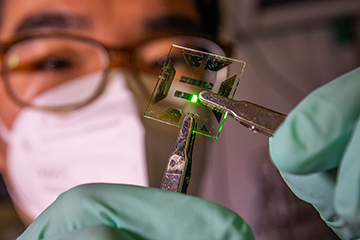
Changyeong Jeong, a University of Michigan Ph.D. candidate, with an ultrathin silver-film-based OLED. The redesigned OLEDs reportedly release 20% more light for a given power input, opening the prospect for improved energy efficiency in some displays. [Image: Robert Coelius/University of Michigan Engineering, Communications & Marketing]
Researchers have developed a more efficient organic LED (OLED) that emits more light with the same amount of power. The upgraded OLED is improved by a new electrode design that uses an ultrathin, transparent silver film, which helps free light that’s typically trapped within the device (Sci. Adv., doi: 10.1126/sciadv.abg0355).
Since the redesigned electrode has a low cost and is simple to produce, it could be easily implemented in commercial OLED manufacturing, the researchers say.
“Industry may be able to liberate more than 40% of the light, in part by trading the conventional indium tin oxide [ITO] electrodes for our nanoscale layer of transparent silver,” Changyeong Jeong, first author and a Ph.D. candidate at the University of Michigan, said in a press release accompanying the research.
Improving inefficiencies
OLEDs have become a staple in our electronic lives. Given their flexibility and low cost, they are commonly used in phones, computers and televisions. Standard OLEDs have an internal quantum efficiency of nearly 100%, meaning that in principle they almost perfectly convert energy into light. But their external quantum efficiency—the share of produced photons that escape from the device—is only around 20%.
In a typical OLED, any light that isn’t emitted at a near perpendicular angle is reflected and guided through the device. These emitted photons are lost due to internal reflections, surface-plasmon-polariton modes, and waveguide modes, which redirect and trap light. While researchers have previously reduced some light-trapping effects with intricate patterned structures, these can be costly and often interfere with the OLED’s electrical operation.
The new work adds to previous efforts by finding a way to completely eliminate light trapping due to waveguide modes without requiring an additional fabrication process. The researchers achieved this by replacing the standard transparent electrode that’s an integral part of an OLED. Instead of using the typical ITO layer, the researchers used a film of silver just 5 nm thick, deposited on a seed layer of copper.
Banishing waveguide modes
The new film is conductive enough to act as an electrode, but thin enough that it eliminates waveguide modes. Through a systematic analysis of the OLED, the researchers were able to determine that the waveguide modes were eliminated due to the silver film’s extreme thinness and the metal’s intrinsic negative permittivity at visible wavelengths.
In combination with other OLED advances that reduce trapped light, such as patterned glass, the new OLED could enable better digital screens that use less power, according to the researchers. Further, they argue, the production of the thin film is compatible with existing manufacturing processes and could be easily implemented by commercial companies. And the findings could potentially be applied to other types of LEDs with similar light-trapping issues including perovskites, quantum dots, and III-V–based LEDs.
“What I am excited about is that we have developed a very practical approach that can be easily adopted in OLED manufacturing without introducing any complicated steps,” said coauthor L. Jay Guo, professor of electrical and computer engineering at the University of Michigan. “Plus the OLED device can be made very flexible, and even bendable due to the mechanical flexibility of the thin metal electrode, as compared with the brittle [ITO] material.”
